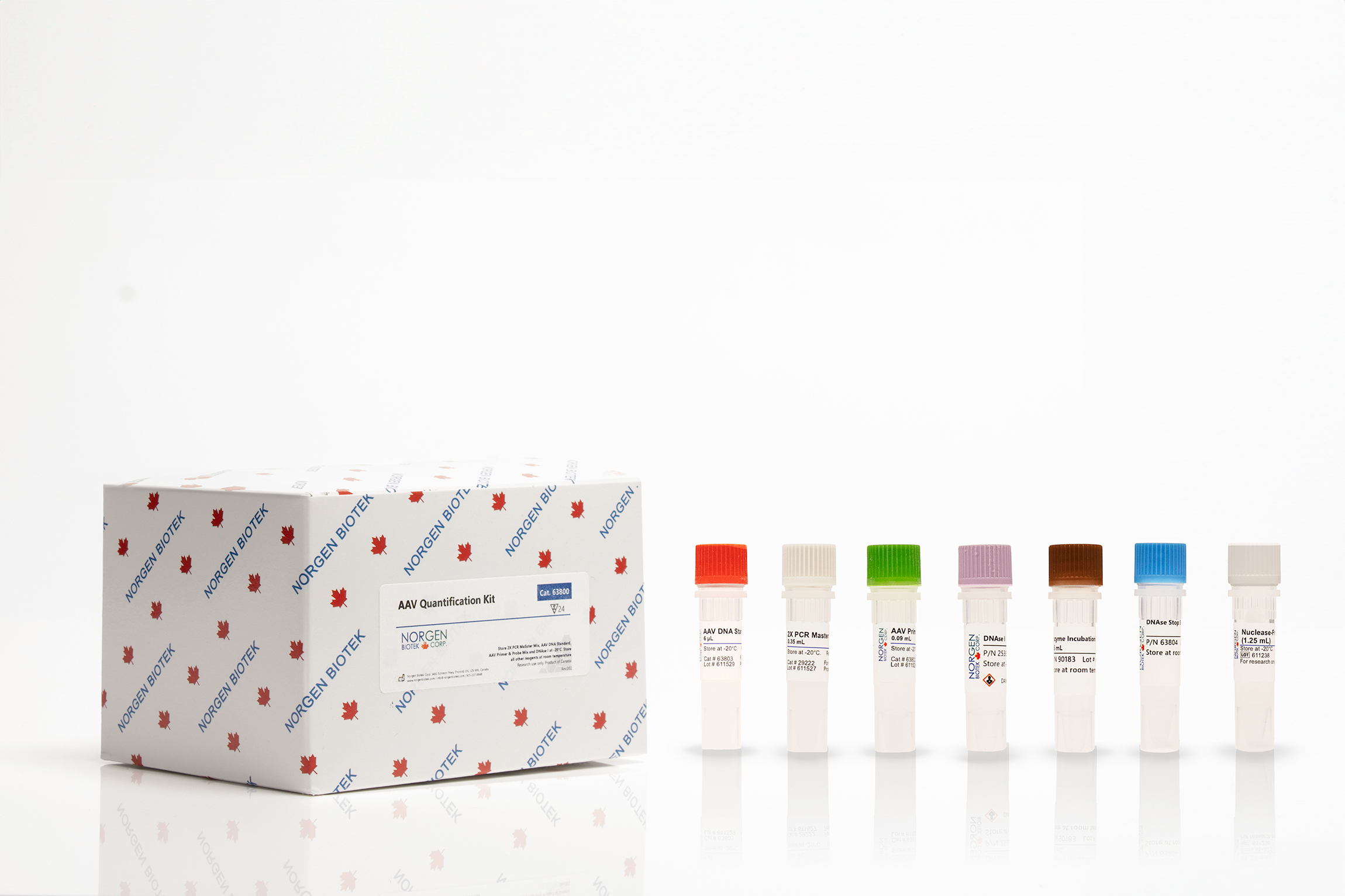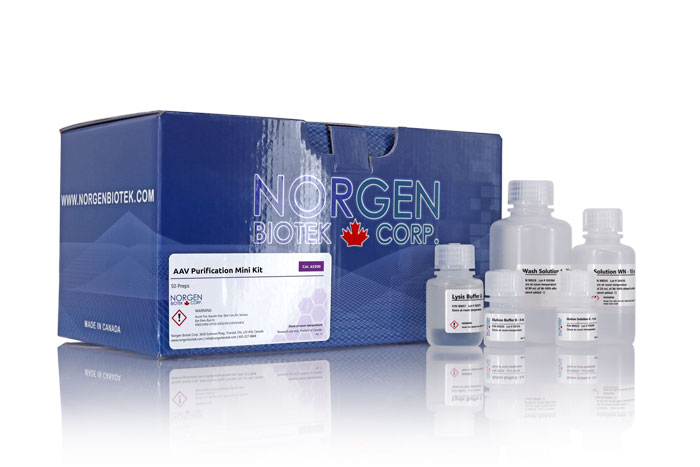AAV Purification Kits

For research use only and NOT intended for in vitro diagnostics.
AAV Purification Kits
Register today to receive an exclusive 15% off* on your first order.
Supporting Data
Figure 1.In vitro transduction. HTX cells transduced with 50 µL eluted vector from the Norgen AAV Purification Kit after purification of cell culture supernatant containing AAV. Both AAV9 and a bovine AAV capsid (isolate AAV-Ca) were tested in vitro on HTX cells. The vector encoded an alkaline phosphatase reporter gene driven by the CAG promoter. Dark/purple staining represents cells that have been transduced by AAV bearing the alkaline phosphatase reporter gene.
Figure 2. In vivo testing of AAV vector purified using the Norgen AAV Purification Kit in the mouse lung. 2 x 1011 ss genomes of an AAV9 vector encoding an alkaline phosphatase reporter gene was delivered via the intranasal route. 1 month post transduction, mouse tissues were harvested. Areas of transduction in the mouse lung are shown by the dark/purple staining where the alkaline phosphatase reporter gene was being expressed.
Figure 3. Transduction of HTX cells using Norgen’s AAV Purification Mini Kit. Microscopic view of HTX cells transduced with biologically active AAV vector after purification using Norgen's AAV Purification Mini Kit (dark purple represents alkaline phosphatase transgene expression).
Figure 4. Linear Scaling of Norgen's AAV Purification Mini Kit From 2.5 mL to 15 mL Input. Purification using Norgen's AAV Purification Mini Kit across different input volumes consisting of mixed cells and supernatant ranging from 2.5 mL to 15 mL. Increased input volumes resulted in no loss of vector as demonstrated by linear scaling across the different volumes.
Figure 5. Transduction of HTX cells with Norgen's AAV Purification Mini Kit with different input volumes of mixed cells and supernatant (0.5 mL. 2.5 mL, 10 mL and 15 mL). Microscopic view of HTX cells transduced with biologically active AAV vector after purification using Norgen's AAV Purification Mini Kit (dark purple represents alkaline phosphatase transgene expression).
Figure 6. Purification from Both Cell Pellet and Supernatant. Purification of AAV vector from both Cell Pellet and Cell Media/Supernatant fraction.
Figure 7. Linear Scaling of Norgen's AAV Purification Midi Kit From 2 mL to 50 mL Input. Purification using Norgen's AAV Purification Midi Kit across different input volumes of mixed cells and supernatant ranging from 2 mL to 50 mL. Increased input volumes resulted in no loss of vector as demonstrated by linear scaling across the different volumes.
Figure 8. Transduction of HTX cells with Norgen's AAV Purification Midi Kit with different input volumes (2 mL, 10 mL and 50 mL) of mixed cells and supernatant. Microscopic view of HTX cells transduced with biologically active AAV vector after purification using Norgen's AAV Purification Midi Kit (dark purple represents alkaline phosphatase transgene expression).
Figure 9. Cellular Transduction of HTX cells with 50 µL of AAV purified using Norgen’s AAV Purification Maxi Slurry Kit. Dark purple staining indicates expression of a human placental alkaline phosphatase reporter gene from AAV transduced cells.
Figure 10. Supernatant from cells transfected with AAV production plasmids was purified using the Norgen AAV Purification Maxi Slurry Kit. Three different volumes were tested: 40, 60 and 80 mL, demonstrating scalable purification of AAV vector over increasing volumes.
|
Kit Specifications
|
|
| Resin Binding Capacity (total per kit) | At least 5 x 1010 AAV particles as determined by qPCR |
| AAV Vector Serotype | AAV6, AAV9 and others |
| Input Type | Cells, media |
| Input Volume (AAV supernatant) | 1 - 33.5 mL SN per prep (500 mL SN in total) |
| Input Volume (AAV cell pellet) | 1 mL cell pellet per prep (15 mL in total) |
| Time to Complete Purifications | 2.5 to 4.5 hours with 1 hour hands on time |
| In vivo transduction | Yes |
Storage Conditions and Product Stability
HL-SAN Nuclease should be stored at -20°C upon arrival. Elution Buffer O should be stored tightly capped at 4°C upon arrival. All other solutions should be kept tightly sealed and stored at room temperature. Once opened, the solutions should be stored at 4°C. This kit is stable for 2 years after the date of shipment.
| Component | Cat. 66100 (15 preps) | Cat. 63200 (20 preps) | Cat. 63300 (4-8 preps) | Cat. 63250 (1-10 preps) |
|---|---|---|---|---|
| Lysis Buffer S | 5.5 mL | 5.5 mL | 5.5 mL | 20 mL |
| DNAse I | - | 2 x 25 uL | 2 x 25 uL | 210 μL |
| RNAse A | - | 60 μL | 60 μL | 240 μL |
| HL-SAN Nuclease | 102 μL | - | - | - |
| Binding Buffer A | 20 mL | 4 mL | 4 mL | 2 x 8 mL |
| Purification Solution C | 60 mL | - | - | - |
| Purification Solution D | 130 mL | - | - | - |
| Wash Solution C | 2 x 130 mL | 60 mL | 60 mL | 3 x 60 mL |
| Slurry E | 12.5 mL | - | - | 2 x 14.5 mL |
| Elution Buffer O | 66 mL | 8.5 mL | 8.5 mL | 66 mL |
| Protein Neutralizer | 4 mL | 4 mL | 4 mL | 4 mL |
| Spin Columns | - | 20 | - | - |
| Mini Spin Columns | - | 20 | - | - |
| Midi Spin Columns (grey contents) with Collection Tubes | - | - | 8 | 10 |
| Midi Spin Columns (white contents) with Collection Tubes | - | - | 8 | - |
| Maxi Spin Columns (grey contents) with Collection Tubes | - | - | - | 10 |
| Maxi Spin Columns (white contents) with Collection Tubes | - | - | - | 10 |
| Collection Tubes | - | 40 | - | - |
| Elution tubes (1.7 mL) | 50 | 20 | - | - |
| Midi Elution tubes (15 mL) | - | - | 8 | 10 |
| Maxi Elution tubes (50 mL) | - | - | - | 10 |
| Product Insert | 1 | 1 | 1 | 1 |
Documentation
FAQs
Mini
AAV sample does not flow through the column due to one or more of the following:
- Centrifugation speed was too low.
Check the centrifuge to ensure that it is capable of generating 1,500 x g. Sufficient centrifugal force is required to move the liquid phase through the resin. - Inadequate spin time.
Spin an additional two minutes to ensure that the liquid is able to flow completely through the column. - Cell debris obstructing column.
Ensure that no cell debris is inadvertently applied to the column following lysate centrifugation. Care should be taken to ensure that only the supernatant is applied to the column. Filtration of supernatant through a 0.2 µm or 0.45 µm filter may decrease clogging of the column. The sample can also be divided among several columns.
Poor AAV recovery could be due to one or more of the following:
- Incorrect pH adjustment of AAV sample for binding.
A pH level of 3.5-3.8 works best for binding AAV to the resin. Ensure that the sample is adjusted to approximately this value with Binding Buffer A prior to sample loading. In phenol red containing media, this will turn the media a bright yellow color. - Initial titer of the sample applied to the column was too low.
A sufficient amount of AAV particles is required in the starting sample to ensure success in downstream applications. It may be required to increase the volume of the starting sample or increase the AAV vector titer of the starting sample by optimizing transfection conditions and/or vector constructs. - Elution Buffer O stored improperly.
Ensure that the Elution Buffer O is aliquoted into 1.5 mL microfuge tubes after opening, taking care to minimize the amount of air left in the tubes (1 mL to 1.5 mL aliquots). Store tightly capped at 4°C.
If a pellet is observed following elution, the input may have been too high for a single column. Spin down elution containing the pellet, and harvest the supernatant, as the AAV vector should mostly be present in the supernatant. The pellet can be re-processed using a fresh column with the cell pellet protocol to harvest the remaining AAV present in the pellet.
Midi
AAV sample does not flow through the column due to one or more of the following:
- Centrifugation speed was too low. Check the centrifuge to ensure that it is capable of generating 1,500 x g. Sufficient centrifugal force is required to move the liquid phase through the resin.
- Inadequate spin time. Spin an additional two minutes to ensure that the liquid is able to flow completely through the column.
- Cell debris obstructing column. Ensure that no cell debris is inadvertently applied to the column following lysate centrifugation. Care should be taken to ensure that only the supernatant is applied to the column. Filtration of the supernatant through a 0.2 µm or 0.45 µm filter may decrease clogging of the column. The sample can also be divided among several columns.
Poor AAV recovery could be due to one or more of the following:
- Incorrect pH adjustment of AAV sample for binding. A pH level of 3.5-3.8 works best for binding AAV to the resin. Ensure that the sample is adjusted to approximately this value with Binding Buffer A prior to sample loading. In phenol red-containing media, this will turn the media a bright yellow color.
- Initial titer of the sample applied to the column was too low. A sufficient amount of AAV particles is required in the starting sample to ensure success in downstream applications. It may be required to increase the volume of the starting sample or increase the AAV vector titer of the starting sample by optimizing transfection conditions and/or vector constructs.
- Elution Buffer O stored improperly. Ensure that the Elution Buffer O is aliquoted into 1.5 mL microfuge tubes after opening, taking care to minimize the amount of air left in the tubes (1 mL to 1.5 mL aliquots). Store tightly capped at 4°C.
If a pellet is observed following elution, the input may have been too high for a single column. Spin down the elution containing the pellet, and harvest the supernatant, as the AAV vector should mostly be present in the supernatant. The pellet can be re-processed using a fresh column with the cell pellet protocol to harvest the remaining AAV present in the pellet.


